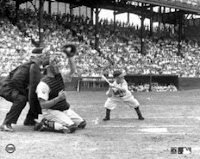When I was in eighth grade, a few friends and I would go to the high school basketball games on Friday nights. I think there were five or six of us. Two of us had older brothers who played for the Sophomore High School team. We'd watch the sophomore game then, after a break, the Varsity High School Team would play. The gymnasium typically filled up for the varsity game but wasn't very crowded for the early game, which gave my friends and I more physical and figurative space to engage with the game. I don't know how many times it happened, but I have strong memories of my friend Tim, whose brother played on the sophomore team, toward the end of the games, pretending he was the coach of the team. Whenever a time-out was called, he'd tell my other friends and I to huddle up. From where we sat on the bleachers, we'd look at him and he'd start barking orders to us, make believing that we were players on the sophomore team. Pointing to one of my other friends, he'd say things like, "Russell, you gotta stick that guy better," or "Mraaz, take it to the hole whenever Hinz feeds you in the lane." Yet, whenever we huddled up, and my friend Tim went into coach mode, I was never assigned the role of a player on the team. Even though my brother played for the team (by my brother's senior year, he made varsity), I was never assigned the role of Erick (my brother). Instead, I was assigned the role of Bucky, the mascot, (Bucky was picked because we lived in Madison, Wisconsin and Bucky Badger was the University Mascot). Tim would say, "Bucky, we need you. Cheer louder."
I was amused by the assignment at the time. In fact, the name stuck and became one of my nick names in middle school. I remember playing hockey on the ice rinks after school and my friends whacking their sticks on the ice and yelling, "Bucky," calling for the puck. I still have somewhat endearing memories of those times in high school even though at some point I realized that assigning the one little person in the group the role of mascot was problematic, being that it reinforces the idea of rubbing the dwarf's head for luck and the idea of objectification if the dwarf is picked as the mascot for no other reason than his or her physical difference.
A story my mother recently told reminded me of my days as Bucky. She and my father were at a Brewers game in Miller Park in Milwaukee, Wisconsin. She said that at some point before the game, a little person wearing a Brewer Uniform ran out onto the field to throw out one of the ceremonial first pitches. She didn't know what to make of it but soon learned the little person was considered the team's lucky charm. She told me she had conflicted feelings about the situation. I agree. While the crowd responds positively to the little person, and the intent is positive, it's hard to feel good about a situation in which a little person is assigned the role of lucky charm simply because of his physical appearance. This goes back to traditional stereotypes of dwarfism and traditional roadblocks that are created as a result of these stereotypes. If a person is defined by his or her physical appearance, it becomes more difficult to be judged according physical and intellectual abilities. Just ask Paul Miller, the Harvard Law Graduate who was a little persona and was rejected by many law firms because of his physical appearance.
After hearing the story from my mother, I tried to find mention of the little person lucky charm on the Milwaukee Brewer website or anywhere on the internet. So far, I haven't found anything so it's hard to know just how official the little person lucky charm actually is. But nevertheless, even if he is an unofficial lucky charm, as my mother said, it still inspires some conflicted feelings.





